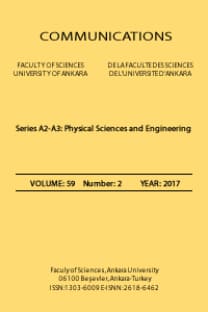Ionization and phonon production by $^{10}$B ions in radiotherapy applications
Ionization and phonon production by $^{10}$B ions in radiotherapy applications
B ion treaphy, polimeric biomaterials, Bragg cure, phonon TRIM Monte Carlo,
___
- Ekinci, F., Bostanci, E., Güzel, M.S., Dagli, O., Effect of different embolization materials on proton beam stereotactic radiosurgery Arteriovenous Malformation dose distributions using the Monte Carlo simulation code, J. Radiat. Res. Appl. Sci., 15 (3) (2022), 191-197, https://doi.org/10.1016/j.jrras.2022.05.011.
- Senirkentli, G.B., Ekinci, F., Bostanci, E., Güzel, M.S., Dagli, Ö., Karim, A.M., Mishra, A., Therapy for mandibula plate phantom, Healthcare, 9 (2021) 167, https://doi.org/10.3390/ healthcare9020167.
- Durante, M., Loeffler, J.S., Charged particles in radiation oncology, Nat. Rev. Clin. Oncol., 7 (2010), 37-43, https://doi.org/10.1038/nrclinonc.2009.183.
- PTCOG, Particle therapy co-operative group, (2020). Available at: https://www.ptcog.ch. [Accessed 20 October 2020].
- Tessonnier, T., Böhlen, T.T., Ceruti, F., Ferrari, A., Sala, P., Brons, S., Haberer, T., Debus, J., Parodi, K., Mairani, A., Dosimetric verification in water of a Monte Carlo treatment planning tool for proton, helium, carbon and oxygen ion beams at the Heidelberg Ion Beam Therapy Center, Phys. Med. Biol., 62 (2017), 6579-6594, https://doi.org/10.1088/1361-6560/aa7be4.
- Tessonnier, T., Mairani, A., Brons, S., Haberer, T., Debus, J., Parodi, K., Experimental dosimetric comparison of 1H, 4He, 12C and 16O scanned ion beams, Phys. Med. Biol., 62 (2017), 3958–3982, https://doi.org/10.1088/1361-6560/aa6516.
- Kozlowska, W.S., Böhlen, T.T., Cuccagna, C., Ferrari, A., Fracchiolla, F., Georg, D., Magro, G., Mairani, A., Schwarz, M., Vlachoudis, V., FLUKA particle therapy tool for Monte Carlo independent calculation of scanned proton and carbon ion beam therapy, Phys. Med. Biol., 64 (2019), 075012, https://doi.org/10.1088/1361-6560/ab02cb.
- Lundkvist, J., Ekman, M., Ericsson, S., Jonsson, B., Glimelius, B., Proton therapy of cancer: Potential clinical advantages and cost-effectiveness, Acta. Oncol., 44 (2005), 850-861, https://doi.org/10.1080/02841860500341157.
- Kempe, J., Gudowska, I., Brahme, A., Depth absorbed dose and LET distributions of therapeutic H1, He4, Li7 and C12 beams, Med. Phys., 34 (2007), 183-192, https://doi.org/10.1118/1.2400621.
- Kantemiris, I., Karaiskos, P., Papagiannis, P., Angelopoulos, A., Dose and dose averaged LET comparison of H1, He4, Li6, Be8, B10, C12, N14 and O16 ion beams forming a spread-out Bragg peak, Med. Phys., 38 (2011), 6585-6591, https://doi.org/10.1118/1.3662911.
- Lourenço, A., Wellock, N., Thomas, R., Homer, M., Bouchard, H., Kanai, T., MacDougall, N., Royle, G., Palmans, H., Theoretical and experimental characterization of novel water-equivalent plastics in clinical high-energy carbon-ion beams, Phys. Med. Biol., 61 (21) (2016), 7623-7638, https://doi.org/10.1088/0031-9155/61/21/7623.
- Arib, M., Medjadj, T., Boudouma, Y., Study of the influence of phantom material and size on the calibration of ionization chambers in terms of absorbed dose to water, J. Appl. Clin. Med. Phys., 7 (2006), 55-64, https://doi.org/10.1120/jacmp.v7i3.2264.
- Samson, D.O., Jafri, M.Z.M., Shukri, A., Hashim, R., Sulaiman, O., Aziz, M.Z.A., Yusof, M. F.M., Measurement of radiation attenuation parameters of modified defatted soy flour–soy protein isolate-based mangrove wood particleboards to be used for CT phantom production, Radiat. Environ. Biophys., 59 (2020), 483–501, https://doi.org/ 10.1007/s00411-020-00844-z.
- Ekinci, F., Bölükdemir, M.H., The effect of the second peak formed in biomaterials used in a slab head phantom on the proton Bragg peak, J. Polytech., 23 (1) (2019), 129-136, https://doi.org/10.2339/politeknik.523001.
- Ekinci, F., Bostanci, E., Dagli, O., Guzel, M.S., Analysis of Bragg curve parameters and lateral straggle for proton and carbon beam, Commun. Fac. Sci. Univ. Ank. Series A2- A3, 63 (1) (2021), 32-41, https://doi.org/10.33769/aupse.864475.
- Stoller, R., Toloczko, M., Was, G., Certain, A., Dwaraknath, S., Garner, F., On the use of SRIM for computing radiation damage exposure, Nucl. Instrum. Methods Phys. Res. B, 310 (2013), 75-80, https://doi.org/10.1016/j.nimb.2013.05.008.
- Kinchin, G.H., Pease, R.S., The displacement of atoms in solids by radiation, Rep. Prog. Phys., 18 (1955), 1-51, https://doi.org/10.1088/0034-4885/18/1/301.
- Ziegler, J.F., Biersack, J.P., Ziegler, M.D., SRIM-The Stopping and Range of Ions in Matter, SRIM Co., Boston, 2008.
- Loeffler, J.S., Durante M., Charged particle therapy optimization. challenges and future directions, Nat. Rev. Clin. Oncol., 10 (2013), 411-424, https://doi.org/10.1038/nrclinonc.2013.79.
- Uhl, M., Mattke, M., Welzel, T., Roeder, F., Oelmann, J., Habl, G., Jensen, A., Ellerbrock, M., Jakel, O., Haberer, T., Herfarth, K., Debus, J., Highly effective treatment of skull base chordoma with carbon ion irradiation using a raster scan technique in 155 patients: first long-term results, Cancer, 120 (2014), 3410-3417, https://doi.org/10.1002/cncr.28877.
- Schulz-Ertner, D., Tsujii, H., Particle radiation therapy using proton and heavier ion beams, J. Clin. Oncol., 25 (2007), 953-964, https://doi.org/10.1200/JCO.2006.09.7816.
- Grun, R., Friedrich, T., Kramer, M., Zink, K., Durante, M., Engenhart-Cabillic, R., Scholz, M., Assessment of potential advantages of relevant ions for particle therapy: a model based study, Med. Phys., 42 (2015), 1037-1047, https://doi.org/10.1118/1.4905374.
- Phillips, T.L., Fu, K.K., Curtis, S.B., Tumor biology of helium and heavy ions, Int. J. Radiat. Oncol. Biol. Phys., 3 (1977), 109-113, https://doi.org/10.1016/0360-3016(77)90236-x.
- Strobele, J., Schreiner, T., Fuchs, H., Georg, D., Comparison of basic features of proton and helium ion pencil beams in water using GATE, Z Med. Phys., 22 (2012), 170-178, https://doi.org/10.1016/j.zemedi.2011.12.001.
- Orecchia, R., Krengli, M., Jereczek-Fossa, B.A., Franzetti, S., Gerard, J.P., Clinical and research validity of hadrontherapy with ion beams, Crit. Rev. Oncol. Hematol., 51 (2004), 81-90, https://doi.org/10.1016/j.critrevonc.2004.04.005.
- Karger, C.P., Jakel, O., Palmans, H., Kanai, T., Dosimetry for ion beam radiotherapy, Phys. Med. Biol., 55 (2010), R193-R234, https://doi.org/10.1088/0031-9155/55/21/R01.
- Qi, M., Yang, Q., Chen, X., Duan, J., Yang, L., Fast calculation of Mont Carlo ion transport code, J. Phys. Conf. Ser., 1739 (2021), 012030, https://doi.org/10.1088/1742-6596/1739/1/012030.
- ISSN: 1303-6009
- Yayın Aralığı: Yılda 2 Sayı
- Başlangıç: 2019
- Yayıncı: Ankara Üniversitesi
Ontology development for web services to be used within the scope of remote monitoring project
Kader GÜRCÜOĞLU, Tunç Durmuş MEDENİ, İhsan Tolga MEDENİ, Mehmet Serdar GÜZEL, Halil ARSLAN
Ömer Faruk YANIK, Hakki Alparslan ILGIN
Ionization and phonon production by $^{10}$B ions in radiotherapy applications
Disease prognosis using machine learning algorithms based on new clinical dataset
Melike ÇOLAK, Talya TÜMER SİVRİ, Nergis PERVAN AKMAN, Ali BERKOL, Yahya EKİCİ
Military camouflage classification with Mask R-CNN algorithm
Airborne imagery and lidar based 3D reconstruction using commercial drones
Koray AÇICI, Ömer Mert ERDAL, Alperen YILMAZ, Metehan UNAL, Gazi Erkan BOSTANCI, Mehmet Serdar GÜZEL
